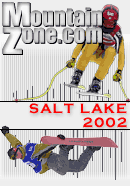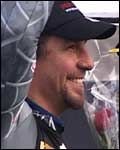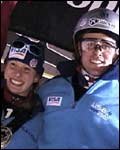|
Ski: Gold Cup
Gold Cup Wild Card Qualifiers
In the last days of 2001, with just over a month until the Olympic Games, eight U.S. athletes qualified for spots the Olympic team. In addition, each winner in his or her respective sports of cross-country, giant slalom, slalom, freestyle moguls, and aerials took home a check for $10,000. These athletes' faces will soon be on Wheaties boxes and Campbell's Soup labels. They are the best on their respective teams and comprise some of the 10 USSA (United States Ski and Snowboard Association) medal hopefuls in this year's Olympics.
Alpine Men's Giant Slalom
Many of Schlopy's friends and family were here in his hometown to cheer him on, a support he called "the 12th man in football, a third leg, a balancing point." This will be Schlopy's second Olympics; he placed 34th in GS in Lillehammer, Norway, in '94. Last season Schlopy had his first two World Cup podium finishes with a 2nd in a GS in Bormio, Italy, and another, behind ski legend Hermann Maier of Austria, at the World Cup Finals in Sweden.
Here at the Gold Cup, Schlopy's combined time was 2:22.31, with Thomas Vonn (Newburgh, NY) finishing 2nd with 2:23.55 and Jake Zamansky (Carbondale, CO) 3rd with 2:25.50.
Alpine Men's Slalom Miller's '98 Olympic appearance in Nagano, Japan, was a challenging one for the then 20 year old. He crashed out in both the GS and slalom and hiked gates to finish the races. His aggressive style of skiing cost him in the previous day's Gold Cup GS when, with a 2nd place spot behind Schlopy going into the second run, he went off course and did not finish. Schlopy and Miller share an apartment outside Innsbruck, Austria, staying in Europe during breaks in the World Cup schedule to reduce their season's travel time. God bless the life of an Olympic ski racer!
Women's Cross Country At 31, Kemppel has been on the US team for 13 years which has seen seven coaches during that time. She predicts the Americans will do better than in previous Olympics because of the continuous program and strong *NOR AM circuit. Trying to imagine the level of training that she has endured for so many years is difficult. She explains that "it's not money, it's not glory, it's what we love to do...four to five hours of training per day." Last year, Kemppel won her 16th US title and posted her best World Cup result, finishing 14th in pursuit at Soldier Hollow and breaking into the top 25 twice in the World Championships. Finishing 2nd at the Gold Cup was Aelin Peterson (Fairbanks, AK) in a combined time of 29:19.3, and 3rd was Barb Jones (Bozeman, MT) in a combined time of 29:42.2.
Men's Cross Country
Justin Wadsworth (Bend, OR) edged out teammate Kris Freeman by .5 seconds to secure his third Olympic berth. With a combined time for the 10km classic and 10km freestyle races of 49:10.7 to Freeman's 49:11.2, it appears that the race was quite close. Teammates noted, however, that Wadsworth was relaxing periodically in the freestyle race, anticipating a final sprint against Freeman. At 33, Wadsworth has seen the peaks and valleys of Nordic racing. He has won four US titles and finished in the top 20 twice in World Cup competition. "We want to persevere in the hardest sport in the world. We (the US team) are all clean athletes in a sport with lots of doping," Wadsworth, who has skipped the World Cup circuit this season to train in Bend, said. Although living well below the altitude of Soldier Hollow, he sleeps in a high altitude atmosphere chamber to simulate living at altitude. Wadsworth's age and his experience specifically at Soldier Hollow will be assets during the Olympic competitions. As 4th place finisher Andrew Johnson remarked, the altitude and the toughness of the course layout are signatures of Soldier Hollow. "The highest part of Soldier Hollow is only a few meters below the legal limit," he said. Fifth place finisher Carl Swensen feels like the US team is in a position for success. "I think it's cleaner than ever — whole programs have been busted, like last year in Finland. Also, testing has gotten better." Soldier Hollow is described as spectator-friendly, with varied terrain, and a phenomenal layout with smooth transitions. With the difficulty of Soldier Hollow, its relatively high altitude, and a more even playing field, the Americans may fare better than ever before on their home course.
Men's Moguls As a coaches' "discretionary selection," Mayer finished 2nd in the Sprint US Grand National World Cup December 14th. He previously distinguished himself as the 2000 Junior Dual Moguls Champion. Mayer beat reigning Olympic moguls champion Jonny Moseley (Tiburon, CA), who holds 13 World Cup titles, the '98 World Cup moguls crown, and the '95 World Championship bronze medal. The young Mayer was humble, saying only that he "was really confident coming in; I had two good weeks of training, but I didn't expect it." The Deer Valley course is long and demanding, 28 degrees from top to bottom, it normally allows for 25 to 30 turns. Again, US athletes who have competed on the course will have a greater familiarity as well as the home crowd advantage.
Women's Moguls Weinbrecht had several insights into the difference between competing at 21 and 36. "These younger guys, they can sleep forever. At 6am, my mind is buzzing." Donna also reflected why younger kids perform so well in the sport. "Getting older, I think and analyze too much. I try to bring the 26 year old to the 36 year old. When I get in that gate, I think that I'm in the Olympics. There is a desire to control every turn, but you can't. It's freestyle!" Donna described the changes in freestyle since she joined the team in '88. "You weren't allowed to take a shovel to a jump. Machine-made courses are technically different. You have to hit the jump; if you miss it, you are finished." This is the first time the mogul team has trained in El Colorado, Chile. The training was particularly good because of the similarity in pitch and altitude. Donna explained that "it was the best training I've ever experienced prior to an Olympic year." Bahrke, who had six top-10 World Cup finishes last year and has placed 4th in two World Cups at Deer Valley, will be furthering her goal to be among the world's top-3 and the best in the US in this year's Olympics. With such experienced athletes and such talented youth, this may be a great Olympic year for the US Women's Mogul Team.
Men's Aerials Bergoust scored 260.54 points to out-jump Park City local Joe Pack, 238.96 points. Jeret Peterson (Boise, ID) finished 3rd with 226.78 points. Bergoust recounted his victory saying, "I was the last guy to jump and the crowd was pumped up and on its feet. It was an exact simulation of how the Olympics is going to be and I hope to jump exactly the same way. I reminded myself that this is what we are up here to do in front of a big crowd. I thought I would be tired, but I'm not. I'm so excited I can't wait." Bergoust has pushed aerials to new heights, perfecting his quad twists (four twists with three flips). Further, he is one of only five people to have done quad flips on the snow. Currently, the FIS (Federacion Internationale du Ski, or International Ski Federation) does not allow quad flips, as the consequences of making a mistake attempting a quad would be much greater than on a triple. Eric designs new tricks on his computer and is arguably the best aerialist in the world. In the spring of '98, Bergoust wrote a paper called Evolution 5/98 asking for a taller and steeper ramp. In the summer of '98, a consistently decreasing radial curve was designed at the Utah Olympic Sports Park "close to the height I wanted," he said. His teammate Jerry Grossi named the new ramp "Mongo." Over the past three years, triple kickers have evolved so that their height and takeoff angle match Mongo's. With Eric's experience and success in world-class competitions, he may be one of the most likely Americans to win gold in this year's Games.
"I can't believe it; I'm going to the Olympics," exclaimed Emily Cook (Belmont, MA). Cook beat Kate Reid 176.03 to 158.35 to secure the women's Olympic aerials wild card spot. Kate was the youngest skier ever named to the US freestyle team in '98 at the age of 14. Now at 18, she put up an honorable contention against the 23-year-old Cook. Jana Lindsey (Black Hawk, SD) finished third with 149.44 points. Cook, along with Deer Valley organizers, was shocked at the New Year's turnout. "The crowd is so absolutely wild; it's totally nuts. But I wouldn't look at the crowd. I couldn't look. I just looked at the jumps, and I'm so excited." Emily started last year on the C-Team but finished with four top-10 World Cup finishes, including her first podium at the Deer Valley event. During the pre-season in Park City, Cook is a part-time coach at Black Diamond gymnastics. "I'm still a kid when I'm over there." Last March, Cook collected her first U.S. aerial's crown in Waterville Valley, New Hampshire, in front of many friends and relatives who live in the Boston area. *NOR AM- A series of International competitions designed to prepare elite athletes for World Cup Competition. These competitions are open to all countries, with heavy participation by the US and Canada. — Art Holscher, MountainZone.com Correspondent
|
|||||||||||||||||||||||||||||||


